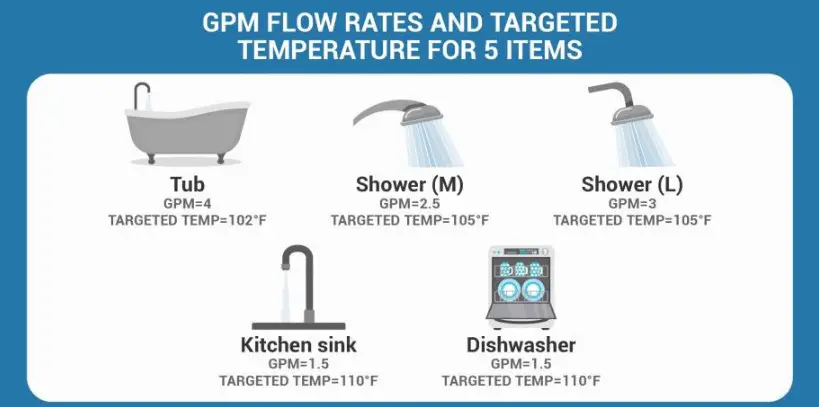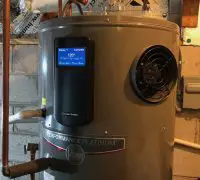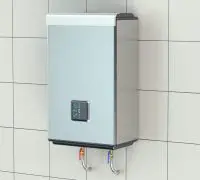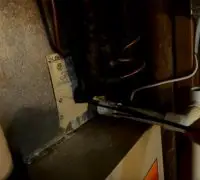If you're looking to fix or replace your Heating or A/C system, we can connect you with a reliable and cost-effective professional in your area.
Should you have concluded that a tankless water heater is the best option for your application, don’t make that purchase just yet. Don’t rush into it at all since there are many things to think about before selecting your tankless water heater.
Not only that, you have to choose between gas and electric, but you also need to get a pencil and a piece of paper to see what are your hot water needs. Once you have the numbers, you can easier decide on the size and maximum flow rate that your next water heater has to provide.
Page Table of Contents
Why is the GPM necessary for your tankless water heater?
Assuming that you know the type of tankless water heater, now you should look into the size, and there are two main aspects to observe.
You need to find the number of gallons per minute (GPM) of hot water that your application requires at peak consumption. Since tankless water heaters don’t come with a tank for collecting the hot water, you really need to sit down and run the numbers.
It’s also essential that you know the needed temperature rise, in which the water temperature and output water temp settings will impact because your unit will give a different GPM according to these factors.
It’s not a good idea to undersize. If the required hot water is higher than the possible maximum, for the shortest amount of time, the tankless water heater will adjust the flow automatically. However, you will have less water at every outlet and a temperature/pressure drop. Any tankless unit that runs at full speed on any given day will wear out faster than was supposed to.
Professionals agree that it’s better that you oversize, even though you may have to pay more upfront.
Is it challenging to find the peak hot water demand?
Needless to say, there are numerous charts online about the standard flow rates at various kinds of water outlets across the U.S. you still need to check the particular fixtures and the manuals for your products.
You need to establish the appliances you use at the same time and how many you will use, adding up the flow rates for each of them.
For instance, if you have to use one kitchen faucet and one shower simultaneously, the maximum water flow will be 4.7GPM (2.2GPM +2.5GPM).
When you have an idea about the maximum demand at peak hours, you will be able to have hot water ready at any moment.
But it’s not only the number of bathrooms that you should consider but also the number of people living in the same house. Even if your house has five bathrooms, there may only be two people showering at the same time.
What are the flow rates in a household?
By now, you should already understand why it’s essential to check the flow rates in your home before selecting your tankless water heater.
The flow rates down below show the total water output, cold, and hot water included. When you’re showering with 2.5GPM shower, not all water will be hot- make sure you’re aware of it. It’s also likely that the hot water demand is lower.
- Handwashing sink- 0.5-1.5GPM
- Bathroom faucet- 2.2GPM
- Bathtub faucet-3.0-4.0GPM
- Showerhead- 2.5GPM
- Kitchen faucet- 2.2GPM
- Dishwasher- 6 gallons per load, and it’s difficult to know the GPM
- Washing machine-23 plus gallons for every load, and not an accurate number for the GPM
We should also remind you that old fixtures will have higher flow rates, and you need to run every appliance individually to identify the precise GPM.
Does the temperature rise also impacts the GPM?
The needed temperature for your unit is also significant, and you have to subtract the heat of the incoming water from the wanted output water temp.
You can measure the water with the thermometer or check the U.S average groundwater temperature map you can find online.
Without getting into details, it’s natural that the temperature of the water is higher in warm regions (77F degrees in southern Florida) and colder in far northern areas (37F degrees in Alaska, for instance).
It’s one thing when your tankless water heater has to heat 77F degrees incoming water, and it’s different when it has to run stronger for heating the 37F degrees.
What’s the result?
After you’ve run all the numbers, you can finally look for the tankless water heater that matches your demands. All manufacturers help customers with sizing charts for the products, where you can see both the maximum flow rates at a specific temperature rise and the other way around. You can also find manufacturers that list flow rates at various input/output water temps.
Most of the time, gas tankless water heaters will handle 5GPM, whereas the electric models can sustain 2GPM. We’re talking about an application where the heater heats the water an entire 70F degrees.
It’s safe to say that tankless water heaters are more powerful, but it depends a lot on the manufacturer. Always check the technical specs and the temperature rise, along with the gallons per minute on a unit.
An example instead of a conclusion
Let’s say that it’s a busy Friday night. Here are the possible hot water demands in your home:
- Downstairs bathroom sink with someone brushing their teeth-0.5-1.5GPM
- The kitchen sink while cooking- 3-7GPM
- A bathroom sink for someone shaving-0.5-1.5GPM
- Two people showering- 3GPM
As you go over the numbers once more, you get something between 7 and 13 gallons per minute for the busy night. It’s quite a load for just one tankless water heater, especially if you live in a cold area where considerable temperature rise is needed.
If you manage to convince your family not to use the shower at the same time, you can get away with 7GPM, but you need to be convincing. Even a gas tankless unit may have difficulties handling the hot water demand.
Best thing? You should plan (it sound dragging, we know) so that your tankless water heater handles the job and doesn’t wear out before its time.
We can definitely connect you with a trusted provider in your area to repair, replace or maintain your heating and A/C systems. Why not let us find a professional for you?






